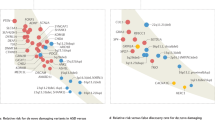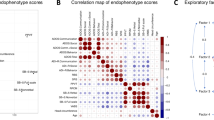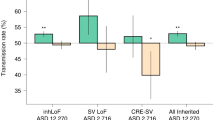Abstract
Recent advances in the genetics of autism spectrum disorders (ASDs) are offering new valuable insights into molecular and cellular mechanisms of pathology. At the same time, the emerging data challenge long-standing diagnostic conventions and the notion of phenotypic specificity. This review addresses the particular issues that attend gene discovery in neuropsychiatric and neurodevelopmental disorders and ASDs in particular, summarizes recent findings in human genetics broadly that are driving the reevaluation of the conventional wisdom regarding the allelic architecture of common psychiatric conditions, reviews selected discoveries in ASDs and their relevance to models of pathology, highlights the conceptual and practical issues raised by the observation of a convergence of ASD genetic risks with distinct psychiatric disorders, and considers the important interplay of studies of neurobiology and genetics in clarifying and extending our understanding of social disability syndromes.
This is a preview of subscription content, access via your institution
Access options
Subscribe to this journal
Receive 12 print issues and online access
$209.00 per year
only $17.42 per issue
Buy this article
- Purchase on Springer Link
- Instant access to full article PDF
Prices may be subject to local taxes which are calculated during checkout


Similar content being viewed by others
References
American Psychiatric Association Task Force on DSM-IV. Diagnostic and Statistical Manual of Mental Disorders: DSM-IV-TR (American Psychiatric Association, Washington, DC, 2000).
Rakic, P. Evolution of the neocortex: a perspective from developmental biology. Nat. Rev. Neurosci. 10, 724–735 (2009).
Hammock, E.A.D. & Levitt, P. The discipline of neurobehavioral development: the emerging interface that builds processes and skills. Hum. Dev. 49, 294–309 (2006).
Geschwind, D.H. Advances in autism. Annu. Rev. Med. 60, 367–380 (2009).
Campbell, D.B. et al. Distinct genetic risk based on association of MET in families with co-occurring autism and gastrointestinal conditions. Pediatrics 123, 1018–1024 (2009).
Ivleva, E.I. et al. Genetics and intermediate phenotypes of the schizophrenia-bipolar disorder boundary. Neurosci. Biobehav. Rev. 34, 897–921 (2010).
State, M.W. The genetics of child psychiatric disorders: focus on autism and Tourette syndrome. Neuron 68, 254–269 (2010).
Chakravarti, A. Population genetics: making sense out of sequence. Nat. Genet. 21, 56–60 (1999).
Risch, N. & Merikangas, K. The future of genetic studies of complex human diseases. Science 273, 1516–1517 (1996).
Reich, D.E. & Lander, E.S. On the allelic spectrum of human disease. Trends Genet. 17, 502–510 (2001).
Altshuler, D., Daly, M.J. & Lander, E.S. Genetic mapping in human disease. Science 322, 881–888 (2008).
Hindorff, L.A. et al. A catalogue of published genome-wide association studies. National Human Genome Research Institute <http://www.genome.gov/gwastudies/> (2010).
Goldstein, D.B. Common genetic variation and human traits. N. Engl. J. Med. 360, 1696–1698 (2009).
Manolio, T.A. et al. Finding the missing heritability of complex diseases. Nature 461, 747–753 (2009).
Cirulli, E.T. & Goldstein, D.B. Uncovering the roles of rare variants in common disease through whole-genome sequencing. Nat. Rev. Genet. 11, 415–425 (2010).
Jamain, S. et al. Mutations of the X-linked genes encoding neuroligins NLGN3 and NLGN4 are associated with autism. Nat. Genet. 34, 27–29 (2003).
Sebat, J. et al. Strong association of de novo copy number mutations with autism. Science 316, 445–449 (2007).
Marshall, C.R. et al. Structural variation of chromosomes in autism spectrum disorder. Am. J. Hum. Genet. 82, 477–488 (2008).
Weiss, L.A. et al. Association between microdeletion and microduplication at 16p11.2 and autism. N. Engl. J. Med. 358, 667–675 (2008).
Levy, D. et al. Rare de novo and transmitted copy-number variation in autistic spectrum disorders. Neuron 70, 886–897 (2011).
Sanders, S.J. et al. Multiple recurrent de novo copy number variations (CNVs), including duplications of the 7q11.23 Williams-Beuren syndrome region, are strongly associated with autism. Neuron 70, 863–885 (2011).
Durand, C.M. et al. Mutations in the gene encoding the synaptic scaffolding protein SHANK3 are associated with autism spectrum disorders. Nat. Genet. 39, 25–27 (2007).
Sousa, I. et al. MET and autism susceptibility: family and case-control studies. Eur. J. Hum. Genet. 17, 749–758 (2009).
Campbell, D.B. et al. A genetic variant that disrupts MET transcription is associated with autism. Proc. Natl. Acad. Sci. USA 103, 16834–16839 (2006).
Jackson, P.B. et al. Further evidence that the rs1858830 C variant in the promoter region of the MET gene is associated with autistic disorder. Autism Res. 2, 232–236 (2009).
Alarcón, M. et al. Linkage, association and gene-expression analyses identify CNTNAP2 as an autism-susceptibility gene. Am. J. Hum. Genet. 82, 150–159 (2008).
Arking, D.E. et al. A common genetic variant in the neurexin superfamily member CNTNAP2 increases familial risk of autism. Am. J. Hum. Genet. 82, 160–164 (2008).
Campbell, D.B., Li, C., Sutcliffe, J.S., Persico, A.M. & Levitt, P. Genetic evidence implicating multiple genes in the MET receptor tyrosine kinase pathway in autism spectrum disorder. Autism Res. 1, 159–168 (2008).
Judson, M.C., Eagleson, K.L., Wang, L. & Levitt, P. Evidence of cell-nonautonomous changes in dendrite and dendritic spine morphology in the Met signaling-deficient mouse forebrain. J. Comp. Neurol. 518, 4463–4478 (2010).
Tyndall, S.J., Patel, S.J. & Walikonis, R.S. Hepatocyte growth factor–induced enhancement of dendritic branching is blocked by inhibitors of N-methyl-D-aspartate receptors and calcium/calmodulin-dependent kinases. J. Neurosci. Res. 85, 2343–2351 (2007).
Gutierrez, H., Dolcet, X., Tolcos, M. & Davies, A. HGF regulates the development of cortical pyramidal dendrites. Development 131, 3717–3726 (2004).
Judson, M.C., Eagleson, K.L. & Levitt, P. A new synaptic player leading to autism risk: Met receptor tyrosine kinase. J. Neurodev. Disord. 3, 282–292 (2011).
Levitt, P. & Campbell, D.B. The genetic and neurobiologic compass points toward common signaling dysfunctions in autism spectrum disorders. J. Clin. Invest. 119, 747–754 (2009).
Bill, B.R. & Geschwind, D.H. Genetic advances in autism: heterogeneity and convergence on shared pathways. Curr. Opin. Genet. Dev. 19, 271–278 (2009).
Judson, M.C., Bergman, M.Y., Campbell, D.B., Eagleson, K.L. & Levitt, P. Dynamic gene and protein expression patterns of the autism-associated met receptor tyrosine kinase in the developing mouse forebrain. J. Comp. Neurol. 513, 511–531 (2009).
Judson, M.C., Amaral, D.G. & Levitt, P. Conserved subcortical and divergent cortical expression of proteins encoded by orthologs of the autism risk gene MET. Cereb. Cortex 21, 1613–1626 (2010).
Geschwind, D.H. & Levitt, P. Autism spectrum disorders: developmental disconnection syndromes. Curr. Opin. Neurobiol. 17, 103–111 (2007).
Qiu, S., Anderson, C.T., Levitt, P. & Shepherd, G.M. Circuit-specific intracortical hyperconnectivity in mice with deletion of the autism-associated met receptor tyrosine kinase. J. Neursci. 31, 5855–5864 (2011).
Campbell, D.B. et al. Disruption of cerebral cortex MET signaling in autism spectrum disorder. Ann. Neurol. 62, 243–250 (2007).
Voineagu, I. et al. Transcriptomic analysis of autistic brain reveals convergent molecular pathology. Nature 474, 380–384 (2011).
Devlin, B., Melhem, N. & Roeder, K. Do common variants play a role in risk for autism? Evidence and theoretical musings. Brain Res. 1380, 78–84 (2011).
Buie, T. et al. Evaluation, diagnosis, and treatment of gastrointestinal disorders in individuals with ASDs: a consensus report. Pediatrics 125 (suppl. 1) S1–S18 (2010).
Sebat, J., Levy, D.L. & McCarthy, S.E. Rare structural variants in schizophrenia: one disorder, multiple mutations; one mutation, multiple disorders. Trends Genet. 25, 528–535 (2009).
McCarthy, S.E. et al. Microduplications of 16p11.2 are associated with schizophrenia. Nat. Genet. 41, 1223–1227 (2009).
Wang, K. et al. Common genetic variants on 5p14.1 associate with autism spectrum disorders. Nature 459, 528–533 (2009).
Weiss, L.A., Arking, D.E., Daly, M.J. & Chakravarti, A. A genome-wide linkage and association scan reveals novel loci for autism. Nature 461, 802–808 (2009).
Anney, R. et al. A genome-wide scan for common alleles affecting risk for autism. Hum. Mol. Genet. 19, 4072–4082 (2010).
Moss, J. & Howlin, P. Autism spectrum disorders in genetic syndromes: implications for diagnosis, intervention and understanding the wider autism spectrum disorder population. J. Intellect. Disabil. Res. 53, 852–873 (2009).
Skuse, D.H. Rethinking the nature of genetic vulnerability to autistic spectrum disorders. Trends Genet. 23, 387–395 (2007).
Bourgeron, T. A synaptic trek to autism. Curr. Opin. Neurobiol. 19, 231–234 (2009).
Laumonnier, F. et al. X-linked mental retardation and autism are associated with a mutation in the NLGN4 gene, a member of the neuroligin family. Am. J. Hum. Genet. 74, 552–557 (2004).
Szatmari, P. et al. Mapping autism risk loci using genetic linkage and chromosomal rearrangements. Nat. Genet. 39, 319–328 (2007).
Bachman, P. et al. Abnormally high EEG alpha synchrony during working memory maintenance in twins discordant for schizophrenia. Schizophr. Res. 103, 293–297 (2008).
Ching, M.S. et al. Deletions of NRXN1 (neurexin-1) predispose to a wide spectrum of developmental disorders. Am. J. Med. Genet. B Neuropsychiatr. Genet. 153B, 937–947 (2010).
Gauthier, J. et al. Novel de novo HANK3 mutation in autistic patients. Am. J. Med. Genet. B. Neuropsychiatr. Genet. 150B, 421–424 (2009).
Berkel, S. et al. Mutations detected in the SHANK2 synaptic scaffolding gene in autism spectrum disorder and mental retardation. Nat. Genet. 42, 489–491 (2010).
Pinto, D. et al. Functional impact of global rare copy number variation in autism spectrum disorders. Nature 466, 368–372 (2010).
Fernandez, T. et al. Disruption of Contactin 4 (CNTN4) results in developmental delay and other features of 3p deletion syndrome. Am. J. Hum. Genet. 82, 1385 (2008).
Fernandez, T. et al. Disruption of contactin 4 (CNTN4) results in developmental delay and other features of 3p deletion syndrome. Am. J. Hum. Genet. 74, 1286–1293 (2004).
Roohi, J. et al. Disruption of contactin 4 in three subjects with autism spectrum disorder. J. Med. Genet. 46, 176–182 (2009).
Glessner, J.T. et al. Autism genome-wide copy number variation reveals ubiquitin and neuronal genes. Nature 459, 569–573 (2009).
Strauss, K.A. et al. Recessive symptomatic focal epilepsy and mutant contactin-associated protein-like 2. N. Engl. J. Med. 354, 1370–1377 (2006).
Bakkaloglu, B. et al. Molecular cytogenetic analysis and resequencing of contactin associated protein–like 2 in autism spectrum disorders. Am. J. Hum. Genet. 82, 165–173 (2008).
Friedman, J.I. et al. CNTNAP2 gene dosage variation is associated with schizophrenia and epilepsy. Mol. Psychiatry 13, 261–266 (2008).
Vernes, S.C. et al. A functional genetic link between distinct developmental language disorders. N. Engl. J. Med. 359, 2337–2345 (2008).
Scott-Van Zeeland, A.A. et al. Altered functional connectivity in frontal lobe circuits is associated with variation in the autism risk gene CNTNAP2. Sci. Transl. Med. 2, 56ra80 (2010).
Stein, M.B. et al. A common genetic variant in the neurexin superfamily member CNTNAP2 is associated with increased risk for selective mutism and social anxiety–related traits. Biol. Psychiatry 69, 825–831 (2011).
Pinto, D. et al. Functional impact of global rare copy number variation in autism spectrum disorders. Nature 466, 368–372 (2010).
Moreno-De-Luca, D. et al. Deletion 17q12 is a recurrent copy number variant that confers high risk of autism and schizophrenia. Am. J. Hum. Genet. 87, 618–630 (2010).
Mefford, H.C. et al. Recurrent rearrangements of chromosome 1q21.1 and variable pediatric phenotypes. N. Engl. J. Med. 359, 1685–1699 (2008).
Kumar, R.A. et al. Association and mutation analyses of 16p11.2 autism candidate genes. PLoS ONE 4, e4582 (2009).
Pober, B.R. Williams-Beuren syndrome. N. Engl. J. Med. 362, 239–252 (2010).
Kumar, R.A. et al. Recurrent 16p11.2 microdeletions in autism. Hum. Mol. Genet. 17, 628–638 (2008).
Ji, W. et al. Rare independent mutations in renal salt handling genes contribute to blood pressure variation. Nat. Genet. 40, 592–599 (2008).
Bochukova, E.G. et al. Large, rare chromosomal deletions associated with severe early-onset obesity. Nature 463, 666–670 (2010).
King, B.H. & Lord, C. Is schizophrenia on the autism spectrum? Brain Res. 1380, 34–41 (2011).
Hoekstra, R.A., Happé, F., Baron-Cohen, S. & Ronald, A. Association between extreme autistic traits and intellectual disability: insights from a general population twin study. Br. J. Psychiatry 195, 531–536 (2009).
Scala, E. et al. MECP2 deletions and genotype-phenotype correlation in Rett syndrome. Am. J. Med. Genet. A 143A, 2775–2784 (2007).
Ehninger, D., Li, W., Fox, K., Stryker, M.P. & Silva, A.J. Reversing neurodevelopmental disorders in adults. Neuron 60, 950–960 (2008).
Guy, J., Gan, J., Selfridge, J., Cobb, S. & Bird, A. Reversal of neurological defects in a mouse model of Rett syndrome. Science 315, 1143–1147 (2007).
Krab, L.C. et al. Effect of simvastatin on cognitive functioning in children with neurofibromatosis type 1: a randomized controlled trial. JAMA 300, 287–294 (2008).
Vernes, S.C. et al. A functional genetic link between distinct developmental language disorders. N. Engl. J. Med. 359, 2337–2345 (2008).
Mukamel, Z. et al. Regulation of MET by FOXP2, genes implicated in higher cognitive dysfunction and autism risk. J. Neurosci. 31, 11437–11442 (2011).
Roll, P. et al. Molecular networks implicated in speech-related disorders: FOXP2 regulates the SRPX2/uPAR complex. Hum. Mol. Genet. 19, 4848–4860 (2010).
Gilman, S.R. et al. Rare de novo variants associated with autism implicate a large functional network of genes involved in formation and function of synapses. Neuron 70, 898–907 (2011).
Akil, H. et al. Medicine. The future of psychiatric research: genomes and neural circuits. Science 327, 1580–1581 (2010).
Ayhan, Y., Sawa, A., Ross, C.A. & Pletnikov, M.V. Animal models of gene-environment interactions in schizophrenia. Behav. Brain Res. 204, 274–281 (2009).
Geschwind, D.H. & Konopka, G. Neuroscience in the era of functional genomics and systems biology. Nature 461, 908–915 (2009).
Acknowledgements
This work has been supported in part by grants from the Simons Foundation (to M.W.S. and P.L.) and the National Institute of Mental Health (MH067842 and MH080759 to P.L. and MH089956 and MH081754 to M.W.S.).
Author information
Authors and Affiliations
Corresponding authors
Ethics declarations
Competing interests
Matthew W. State co-holds a patent pertaining to rare variation in the CNTNAP2 gene and the risk for autism spectrum disorders.
Rights and permissions
About this article
Cite this article
State, M., Levitt, P. The conundrums of understanding genetic risks for autism spectrum disorders. Nat Neurosci 14, 1499–1506 (2011). https://doi.org/10.1038/nn.2924
Published:
Issue Date:
DOI: https://doi.org/10.1038/nn.2924
This article is cited by
-
Childhood Academic Performance: A Potential Marker of Genetic Liability to Autism
Journal of Autism and Developmental Disorders (2023)
-
Deletion of TRPC6, an Autism Risk Gene, Induces Hyperexcitability in Cortical Neurons Derived from Human Pluripotent Stem Cells
Molecular Neurobiology (2023)
-
Novel probiotic treatment of autism spectrum disorder associated social behavioral symptoms in two rodent models
Scientific Reports (2022)
-
Polygenic risk for autism spectrum disorder affects left amygdala activity and negative emotion in schizophrenia
Translational Psychiatry (2020)



